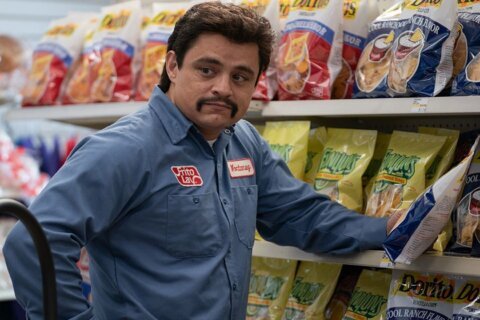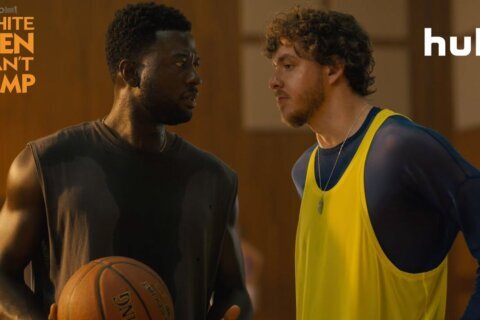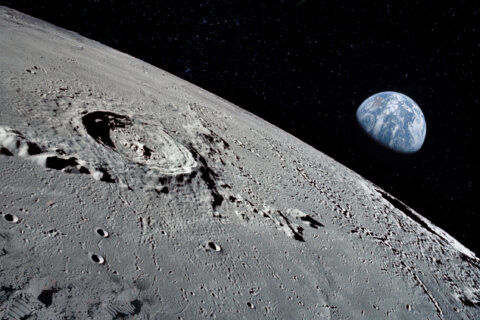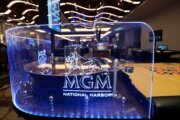Jason Fraley, WTOP Film Critic
WASHINGTON – From the “X-Men” (2000)” to “Spider-Man” (2002) to “The Dark Knight” (2008), 21st-century Hollywood has been all about the comic book superhero. And of all the efforts so far, “The Avengers” may be the most shrewd business scheme Hollywood has ever dreamed up.
You can hear the studio execs now: “Rather than make one superhero movie, let’s make five! We’ll introduce different superheroes along the way, then bring them all together in one super-blockbuster!”
“The Avengers” is thus the culmination of Marvel’s “Iron Man (2008), “The Incredible Hulk” (2008), “Iron Man 2” (2010), “Thor” (2011) and “Captain America” (2011). Robert Downey Jr. is back as suave tech genius Tony Stark/Iron Man; Chris Evans revives his patriotic Steve Rogers/Captain America; and Chris Hemsworth returns as the hammer-wielding Thor.
They’re assembled by S.H.I.E.L.D. leader Nick Fury (Samuel L. Jackson, a.k.a. Mr. Glass) to fight alongside Hawkeye (Jeremy Renner), Erik Selvig (Stellan Skarsgard) and Natasha Romanoff (Scarlett Johansson). Their nemesis? Thor’s evil alien brother Loki (Tom Hiddleston), who uses a portal device known as the Tesseract to unleash hell on earth.
The one missing piece is Edward Norton as Bruce Banner/The Hulk. Norton reportedly loved the concept of joining forces, but demanded that Banner must somehow grow as a character. When the script failed to do this, Norton opted out, and he was replaced by Mark Ruffalo (“Shutter Island”).
Not only does this take the air out of the “assemble” gimmick, it highlights the film’s main problem: a lack of character development. To me, what makes superhero movies great is the hero’s journey. We see Bruce Wayne lose his parents. We see Clark Kent grow up on a remote farm in Smallville. We see Peter Parker get bit by the spider. Then we watch them grow into their powers and save the world.
In “The Avengers,” the meaningful part of the character arc is gone. The superheroes mutate, but they don’t grow. This is the added challenge of sequels. Writer/director Joss Whedon (“Buffy the Vampire Slayer”) feels less like a master filmmaker and more like a kid in a toy store, smashing action figures around in battle after battle for 2 1/2 hours. As the CGI buildings are blown to bits, you can almost hear the Jenga pile crumbling down. It’s amazing how bored we can get amidst so much action.
Whether it’s movies or comics or sports, the journey matters. Instead of watching the heroic rise of Michael Jordan, “The Avengers” is like watching an NBA All-Star Game. It’s cool to see the individual stars combine forces for spectacular offense (Hulk Smashes, laugh lines, special effects). But after a while, we’re left craving some defense (a director’s vision, testing historical and academic scrutiny). Diehard Marvel fans may call it a slam dunk, but film history won’t remember who won this game.
It’s absolutely possible to make an entertaining movie that’s also artfully done. John Ford’s “The Searchers” (1956), Hitchcock’s “Rear Window” (1954) and Coppola’s “The Godfather” (1972) are some of my favorite examples. These were popular, mainstream flicks, starring John Wayne, Jimmy Stewart and Al Pacino, and yet they still had “strong directors” who understood film theory. I realize most people don’t care about this stuff, but it’s the job of us critics to hold films to a higher standard. These filmic techniques aren’t a waste of time; they affect viewers subconsciously and add an element of “art” to the process. This is why I’m looking forward to “The Dark Knight Rises” this summer, because director Christopher Nolan has shown potential ever since “Memento” (2000).
Tentpole movies serve as a barometer of the industry, and it’s sad to think “The Avengers” marks this time like “Casablanca” did the Golden Age. Clearly, I’m lamenting the overall direction of Hollywood more than I am this single film. The last thing I want to do is diminish the charm of Whedon’s storytelling. He provides thrilling “Hulk Smash” surprises, drops plenty of pop culture references like “Galaga” and feeds Downey zingers that put the “comic” in Marvel comics. He even weaves in post-9/11 themes with a Manhattan Stark Tower resembling One World Trade Center, reminding us that in such serious times “maybe we need to be old-fashioned.” He says it twice, once in describing the classic costume of Captain America, and again in Samuel L. Jackson’s unity speech.
Unfortunately, his successes are lost in the overblown nature of the beast. Even the “old-fashioned” theme was shattered by technical glitches at the 3D IMAX screening Tuesday at the Regal Majestic in Silver Spring. The packed house groaned at numerous moments of digital skipping, similar to scratches on your DVD, causing one man to cry out, “(Screw) digital!” Later, the left eye of everyone’s 3D glasses went dark. I hoped it was an ode to Jackson’s eye patch, but there was no narrative to support it. As we exited the theater, we were given “re-admission” tickets in an attempt at forgiveness.
Clearly, this isn’t the film’s fault, but it got me thinking. “Hugo” and “Titanic” have me warming up to the potential of 3D, but “maybe we need a little old-fashion.” If not in presentation (new technology is inevitable), then at least in cinematic understanding (studying the greats of the past). It can even be the recent past, like “Pulp Fiction,” which cast Nick Fury; “Fight Club,” which cast Bruce Banner, or “Eternal Sunshine,” which cast his replacement. Show us something original, cinematic, profound. Then entertain us. You’ll gain the love of not only the fanboys, but also the respect of history.
Let’s hold our directors to a higher standard, so that they will hold us to a higher standard as audiences. We should strive to be cinematic Tony Starks, smooth in our movie history knowledge, and unlike Steve Rogers, who doesn’t get the references. This is a call to all those who deeply want to understand what makes great films great. Study them. Dissect them. Then make them. As Stark says, “Humans may not be able to protect the earth, but we will avenge it.” Filmmakers may not be able to protect Hollywood from going in a dangerous direction, but they can avenge it.
Avengers Assemble.
★ ★ 1/2 (Original Rating)
★ ★ ★ (Revised Rating based on second home viewing)
The above rating is based on a 4-star system: 4 = potential masterpiece, 3.5 = great movie, 3 = good movie, 2.5 = solid, above average flick, 2 = disappointingly mediocre, 1.5 = don’t waste your time, 1= terrible. Read more from WTOP Film Critic Jason Fraley by clicking “Fraley on Film” under the “Living” tab above, and check out his blog, The Film Spectrum.
(Copyright 2012 by WTOP. All Rights Reserved.)








